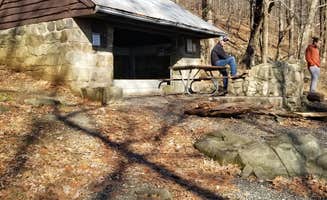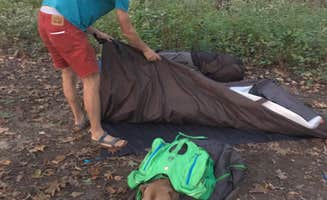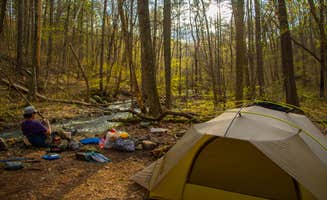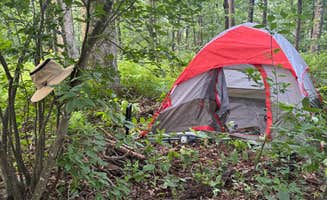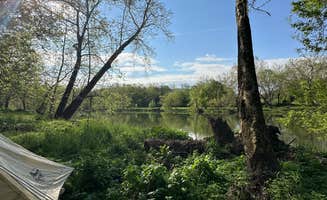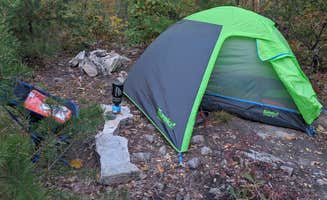Dispersed camping near Remington, Virginia exists primarily in the Shenandoah Valley region, with elevations ranging from 500 to 3,000 feet across camping areas. Summer temperatures average 75-85°F during day and 55-65°F at night, while spring and fall camping requires preparation for temperature swings of 30+ degrees. Many primitive sites lack formal facilities and require campers to pack in all necessary supplies.
What to do
Hiking on established trails: The Veach Gap trail offers a moderately challenging 4-mile hike with 1,200 feet of elevation gain leading to Veach Gap - GWNF - Backpacking Site, where campers can experience "breathtaking views of the Shenandoah River and surrounding mountains" according to TJ W. Pack enough water for your entire stay as "there is no water after the first mile."
River activities: South Fork Shenandoah River provides direct river access with "a launch in the middle, so there is a bit of come and go" per Heather's review. The campsites border the water with good fishing access, though be aware that flooding can make sites "completely un-campable" after heavy rains.
Mountain exploration: Backcountry sites at Laurel Prong Trail offer more secluded primitive camping near Remington with "good views on the hike" according to Nora S., though finding ideal camping spots can be challenging as "it was not particularly easy to find and we couldn't find a super great spot."
What campers like
Fire rings at established sites: Unlike Shenandoah National Park's no-fire policy, Little Fort Campground offers established sites with "a fire ring, a picnic table, and a flat area to pitch a tent" as noted by A Dan needs A. Each site has a designated parking spot and campers select sites using a washer system—"flip it from green to red" when occupied.
Wildlife encounters: Primitive camping opportunities offer close wildlife viewing, though proper precautions are essential. Allan M. reports at Laurel Prong Trail Dispersed that "bears were constantly checking out our tent during night" and advises "100% do not have food scents near your tent."
Seasonal flexibility: Camping areas around Remington offer year-round options with varying conditions. Matthew M. found Little Fort Campground accessible even during holiday weekends: "Got the last site at 6PM on the Friday of Memorial Day weekend." Fall camping brings changing leaves, while spring requires layering for temperature fluctuations.
What you should know
No cell service: Most primitive sites have extremely limited connectivity. Lindsay C. notes about Little Fort Campground: "I have a Verizon prepaid plan and I had no service at all starting from about 20 minutes away from the site, so I wouldn't count on having any reception."
Limited facilities: Gravel Springs Hut provides basic shelter on the Appalachian Trail with "a picnic table, privy, bear locker, and bear pole to hang additional items at the site" according to Mara F. The hut "sleeps 8 and is first come, first serve" with tent sites available if the hut is full.
Weather preparedness: Temperature variations require adaptable gear. Pack extra layers, especially during spring and fall when nighttime temperatures can drop significantly. Rangers recommend bringing sufficient water, as many primitive sites lack reliable water sources.
Permit requirements: Backcountry sites in Shenandoah National Park require permits, while George Washington National Forest sites typically do not. Check current regulations before arrival as they change seasonally.
Tips for camping with families
Choose accessible sites: For families with young children, Crisman Hollow Road Camp offers drive-up sites "with many spots right on the water" and "one really nice hiking trail by the bridge" according to Waseem H., making it suitable for shorter adventures with children.
Wildlife safety education: Teach children proper food storage techniques and wildlife awareness. Sites throughout the region have active black bear populations that require vigilance with food storage.
Bring all supplies: Most primitive camping areas near Remington lack amenities. A Dan needs A. reminds campers at Little Fort Campground that there's "nowhere to dump trash, pack it out when you leave" and "no running water here."
Plan for bathroom limitations: Many dispersed sites lack facilities. Sites with toilets often have vault toilets or outhouses that may not be regularly maintained. According to Ashley F.'s experience at another site, prepare for facilities that might be "pretty gross" and bring sanitizer and toilet paper.
Tips from RVers
Road access considerations: Many primitive camping areas near Remington have challenging access roads. Sumner C. notes that while South Fork Shenandoah River has a "road to get to the campsite [that] was well maintained and easy to get to," many other forest roads require high-clearance vehicles.
Site selection for larger vehicles: Compton Gap Backcountry camping and similar areas are not suitable for RVs due to access limitations and lack of designated parking. Les R. notes it's more suitable for "through hikers" than recreational campers with larger equipment.
Weather impact planning: Consider how recent weather affects accessibility. Heather notes that after hurricane rains, South Fork Shenandoah River sites were "underwater or filled with river mud, making them completely un-campable."


